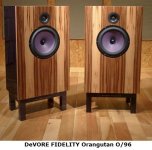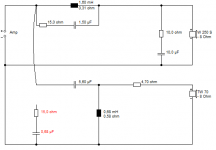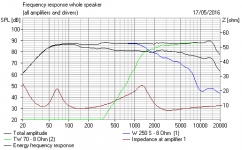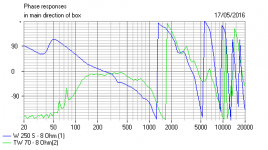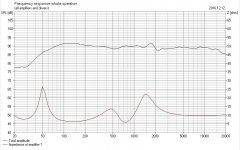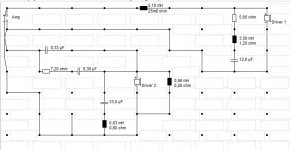that seas tweet, Fs looks nice and low with a shallow peak at Fs, great for a 6db crossover.
90db seems nice.
the seas t35 tweet is a bit more sensitive, so the cap value may be off, but you may be able to get away with a single cap on it, or a 1-2ohm resistor, but then you may need a different value cap. Maybe need 3 different caps to try single cap, then 1ohm + diff cap, then 2 ohm + different cap.
But......................
Go for it !!!!!!!!!!!!!
I'd be interested in your results !!!!!!!!!!!
especially if you make a tweeter box to sit on the woofer box.
That way you can align it, and build another box when (if) you try a different tweeter.
90db seems nice.
the seas t35 tweet is a bit more sensitive, so the cap value may be off, but you may be able to get away with a single cap on it, or a 1-2ohm resistor, but then you may need a different value cap. Maybe need 3 different caps to try single cap, then 1ohm + diff cap, then 2 ohm + different cap.
But......................
Go for it !!!!!!!!!!!!!
I'd be interested in your results !!!!!!!!!!!
especially if you make a tweeter box to sit on the woofer box.
That way you can align it, and build another box when (if) you try a different tweeter.
So after considering the responses here and some research, I am thinking about trying an aperiodic vented 64 liter cabinet for the Seas A26RE4 woofer and Seas 27TDFC tweeter. That would mimic an almost 3ft^3 sealed cabinet. Any reason why this is a bad idea?
Yes, one - aperiodic will not mimic a larger sealer cabinet. It will drop the Qtc to the same value as the sealed cabinet in comparison but will reduce significantly your bass output. It will also reduce the group delay below that of the sealed box ( by an ignorable margin ) under the knee of the aperiodic box and will increase it above in a single octave region, which would be more noticeable due to being higher in frequency. The aperiodic will also provide a slightly reduced cone stroke for a given constant power. If you ask me, it isn`t worth the hassle.
So after considering the responses here and some research, I am thinking about trying an aperiodic vented 64 liter cabinet for the Seas A26RE4 woofer and Seas 27TDFC tweeter. That would mimic an almost 3ft^3 sealed cabinet. Any reason why this is a bad idea?
I looked into Peter Comeau's WDT EX 50/60L cabinet, and it was actually dual chamber with an INTERNAL aperiodic slot. The main reason, IMO, being to avoid having to overly stuff the long section resonance.
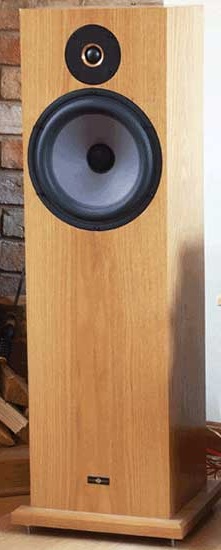
Plans here: http://www.diyaudio.com/forums/multi-way/291346-seas-a26-oversize-cabinet.html#post4715609
IMO, it's the CONCEPT that is important. Not the detailed implementation. 10" bass plus a tweeter that can do low crossover is where it's at. A 3.5kHz notch on the bass is no bad thing either.
A wide closed box in more golden ratio might be good here. Big baffles add about 1db level below 1kHz, so you need to raise tweeter level.
I've done this with a regular 10" bass and cone tweeter which resembles a waveguide tweeter in some respects, because dispersion falls away at HF. With a dome tweeter, the tweeter filter tends more to first order.
But look at that power response. Remarkable for a 10" bass. It'll sound OK to the sides. 😎
Oh, and as the icing on the cake, I've pretty much matched John Devore's impedance, so I think I'm on the right track:
http://www.stereophile.com/content/devore-fidelity-orangutan-o96-loudspeaker-measurements#
Attachments
Last edited:
Member
Joined 2009
Paid Member
Thos Devor drivers have phase plugs instead of a dust cap that the A26 comes with so how close a 'clone' is this ?
Member
Joined 2009
Paid Member
Is the A26 woofer deficient as is - would a phase plug make much of an improvement do you think ? given that Seas didn't think it was necessary ?
Oh, and as the icing on the cake, I've pretty much matched John Devore's impedance, so I think I'm on the right track:
http://www.stereophile.com/content/devore-fidelity-orangutan-o96-loudspeaker-measurements#
So which tweeter did you use in your model?
Those were lower efficiency Visaton drivers. The W250S and TW 70 tweeter.
But that is mere detail. The low crossover and notch are the main event.
I've owned speakers like this. All two ways being compromised, this one has poor dispersion at high frequencies, but solid bass and middle
Big 8"-12" cones get away with simple filters, having tidy mechanical roll off.
But that is mere detail. The low crossover and notch are the main event.
I've owned speakers like this. All two ways being compromised, this one has poor dispersion at high frequencies, but solid bass and middle
Big 8"-12" cones get away with simple filters, having tidy mechanical roll off.
May I a little bit closer. Simulation based on A26 and Morel measurement on the same box.Those were lower efficiency Visaton drivers. The W250S and TW 70 tweeter.
But that is mere detail. The low crossover and notch are the main event.
I've owned speakers like this. All two ways being compromised, this one has poor dispersion at high frequencies, but solid bass and middle
Big 8"-12" cones get away with simple filters, having tidy mechanical roll off.
Attachments
Last edited:
Hello Everyone!
This Orangutan clone is extremely interesting. I really like how the Madisound A26 speaker kit has a single capacitor on the tweeter. Although, that tweeter is crazy expensive!
Could a different tweeter be used while still using a simple single-cap crossover? The Hiquphon tweeters seem to have similar curves, are highly regarded, and are about half the price of the Seas tweeters.
HIQUPHON dome tweeter OWI, OWII, OWIII, OW3, OW4
As someone else pointed out, the ScanSpeak Discovery R2604/8320 tweeters look extremely good too, and are $50/piece!
Sorry, I just have zero knowledge on crossover design. I'd really love to build these with cheaper tweeters. The A26's hi-pass of 6000hz baffles me as well.
This Orangutan clone is extremely interesting. I really like how the Madisound A26 speaker kit has a single capacitor on the tweeter. Although, that tweeter is crazy expensive!
Could a different tweeter be used while still using a simple single-cap crossover? The Hiquphon tweeters seem to have similar curves, are highly regarded, and are about half the price of the Seas tweeters.
HIQUPHON dome tweeter OWI, OWII, OWIII, OW3, OW4
As someone else pointed out, the ScanSpeak Discovery R2604/8320 tweeters look extremely good too, and are $50/piece!
Sorry, I just have zero knowledge on crossover design. I'd really love to build these with cheaper tweeters. The A26's hi-pass of 6000hz baffles me as well.
Studying the roll-off of the Seas tweeter, the Hiquphon OWII seems to have the most similar FR. It also conveniently is an 8 Ohm driver with a sensitivity of 90dB/1W! A +/- .5dB matched pair runs $252
Anybody know if this will work with a simple 3.3uf cap?
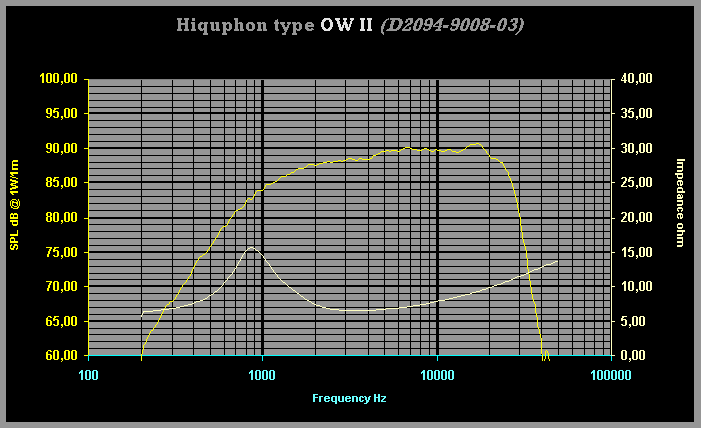
OW-II FR
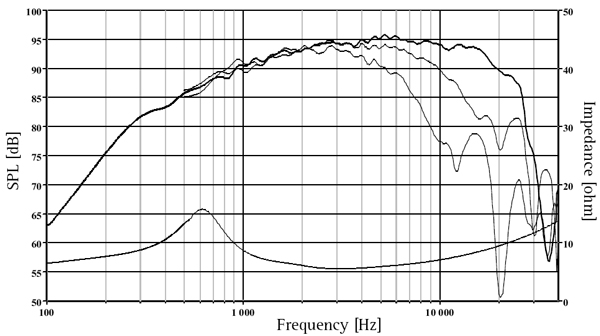
Seas Excel T35C-002 FR]
Anybody know if this will work with a simple 3.3uf cap?

OW-II FR

Seas Excel T35C-002 FR]
Last edited by a moderator:
I suspect 'not great'. 1st order electrical filters can't prevent excursion increasing below the XO frequency without assistance, as Lynn Olson points out elsewhere, so even with a relatively high nominal, that little 3/4in dome would be pushed very hard. Too hard IMO; it would be a waste of its performance, and note that the dispersion properties would likely be significantly different through the transition band. The reason the Seas kit works is that large (and excellent) 1.5in dome -even then distortion will be rising if it's pushed hard.
As I recall, the A26 driver was created by Seas for the defunct World Designs WD25 kits that Peter Comeau designed before he left to take up his post at IAG. There were several versions as I recall, using different tweeters (Excel, then the Millennium as the top model). Their own simpler kit / plan, which if memory serves is closer in engineering terms to the A25 kit, appeared a little later.
As I recall, the A26 driver was created by Seas for the defunct World Designs WD25 kits that Peter Comeau designed before he left to take up his post at IAG. There were several versions as I recall, using different tweeters (Excel, then the Millennium as the top model). Their own simpler kit / plan, which if memory serves is closer in engineering terms to the A25 kit, appeared a little later.
Again I don't know much about crossovers, but isn't -18dB @ Fs the (generous) general rule for tweeters?
So given this rule of thumb, a 3.3uF cap is a 6000hz high-pass. -18dB would be then at 750Hz.
Just going off this rule of thumb, the ScanSpeak Discovery R2604/8330 and SB Acoustics SATORI TW29RN are both covered by this rule. The Hiquphon OWII has a Fs of 850Hz, slightly out of the rule of thumb.
So given this rule of thumb, a 3.3uF cap is a 6000hz high-pass. -18dB would be then at 750Hz.
Just going off this rule of thumb, the ScanSpeak Discovery R2604/8330 and SB Acoustics SATORI TW29RN are both covered by this rule. The Hiquphon OWII has a Fs of 850Hz, slightly out of the rule of thumb.
Unless you are using them as nearfield monitors at low levels, that tweeter is not going to be very happy.
-Excursion will be increasing below the crossover frequency (1st order cannot prevent that from happening without other measures) and it's going to be 'seeing' a fair bit of electrical power, especially at resonance if there isn't an LCR notch flattening that out, which will also foul up the transfer function & acoustic slope (although that to a point applies to the Excel tweeter).
-It only has about 2/3 the radiating area of a typical 1in dome and about 1/2 that of the T35
-Harmonic distortion on these smaller dome tweeters tends to rise quite rapidly below about 2KHz, and its not getting much electrical protection nor any help to reduce excursion
-The above is nominal based on 1m power requirements only, & the further off you are, the more power is getting through to it, and the less happy it will be. And those A26 drivers can take a lot of power. If you want an ROT that is useful: when designing a speaker, it's better if the bass drivers start to protest before the tweeter does. In their case, they're only likely to start compressing / running into excessive distortion, rather than frying. 😉
-Its dispersion performance and that of the big Seas bass unit are very different increasing the chance for off-axis issues through the transition band.
For me, those appear to be fatal objections. The OWII is an excellent tweeter when used well. This is not really using it well. As noted, the big Seas T35 can get away with it due to greater size / efficiency / power-handling & LF distortion performance, and even it will probably start to protest a bit at high SPLs.
-Excursion will be increasing below the crossover frequency (1st order cannot prevent that from happening without other measures) and it's going to be 'seeing' a fair bit of electrical power, especially at resonance if there isn't an LCR notch flattening that out, which will also foul up the transfer function & acoustic slope (although that to a point applies to the Excel tweeter).
-It only has about 2/3 the radiating area of a typical 1in dome and about 1/2 that of the T35
-Harmonic distortion on these smaller dome tweeters tends to rise quite rapidly below about 2KHz, and its not getting much electrical protection nor any help to reduce excursion
-The above is nominal based on 1m power requirements only, & the further off you are, the more power is getting through to it, and the less happy it will be. And those A26 drivers can take a lot of power. If you want an ROT that is useful: when designing a speaker, it's better if the bass drivers start to protest before the tweeter does. In their case, they're only likely to start compressing / running into excessive distortion, rather than frying. 😉
-Its dispersion performance and that of the big Seas bass unit are very different increasing the chance for off-axis issues through the transition band.
For me, those appear to be fatal objections. The OWII is an excellent tweeter when used well. This is not really using it well. As noted, the big Seas T35 can get away with it due to greater size / efficiency / power-handling & LF distortion performance, and even it will probably start to protest a bit at high SPLs.
Last edited:
Member
Joined 2009
Paid Member
Maybe something here of interest: http://www.diyaudio.com/forums/multi-way/259868-orangutan-lookalike.html
Last edited:
There are three things important to consider in building a design such ad this;Hello Everyone!
This Orangutan clone is extremely interesting. I really like how the Madisound A26 speaker kit has a single capacitor on the tweeter. Although, that tweeter is crazy expensive!
Could a different tweeter be used while still using a simple single-cap crossover? The Hiquphon tweeters seem to have similar curves, are highly regarded, and are about half the price of the Seas tweeters.
HIQUPHON dome tweeter OWI, OWII, OWIII, OW3, OW4
As someone else pointed out, the ScanSpeak Discovery R2604/8320 tweeters look extremely good too, and are $50/piece!
Sorry, I just have zero knowledge on crossover design. I'd really love to build these with cheaper tweeters. The A26's hi-pass of 6000hz baffles me as well.
The tweeter crossover should be set at twice (or more) the tweeter's resonant frequency to avoid damage from overheating.
Woofers will 'beam' and become increasingly directional as the frequency they reproduce increases. This paper driver is well behaved because of the heavy composition.
These benefit from careful placement in corners, at some distance from the listener and are NOT the most revealing monitors
They can be very musical, and are relatively easy to build.
I've made the simplest A26 kit, which runs the woofer full range. It was tolerable, but not great. I highly recommend consideration of the more advanced crossover designs that are detailed above.
If you can find a pair of Snell Type E or Dynaco A25 for a 'test drive', audition them first.
In my opinion, this design has many unnecessary compromises given available drivers at similar cost.
2 videos just arrived on youtube of a seas a26 plus morel cat378 (from Carl M).
Can't tell you any specifics on crossover.
https://www.youtube.com/watch?v=aZ-4aY1jRhg
https://www.youtube.com/watch?v=-j-OBzl6od4
Can't tell you any specifics on crossover.
https://www.youtube.com/watch?v=aZ-4aY1jRhg
https://www.youtube.com/watch?v=-j-OBzl6od4
Perhaps the horn loaded Peerless DX20 if crossed over high enough?
https://www.parts-express.com/pedoc...0bf00-04-silk-dome-tweeter-specifications.pdf
As Lojzek pointed out with the A26, adding a 2nd order filter to the HP was really helpful. Quite possibly it would help here too.
Best,
E
https://www.parts-express.com/pedoc...0bf00-04-silk-dome-tweeter-specifications.pdf
As Lojzek pointed out with the A26, adding a 2nd order filter to the HP was really helpful. Quite possibly it would help here too.
Best,
E
- Home
- Loudspeakers
- Multi-Way
- Devore Orangutan Clone?
